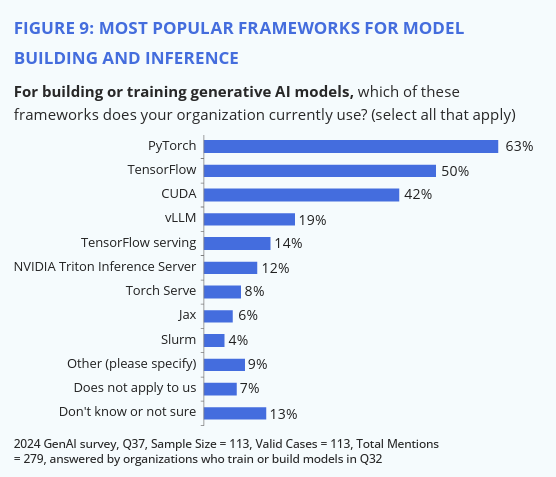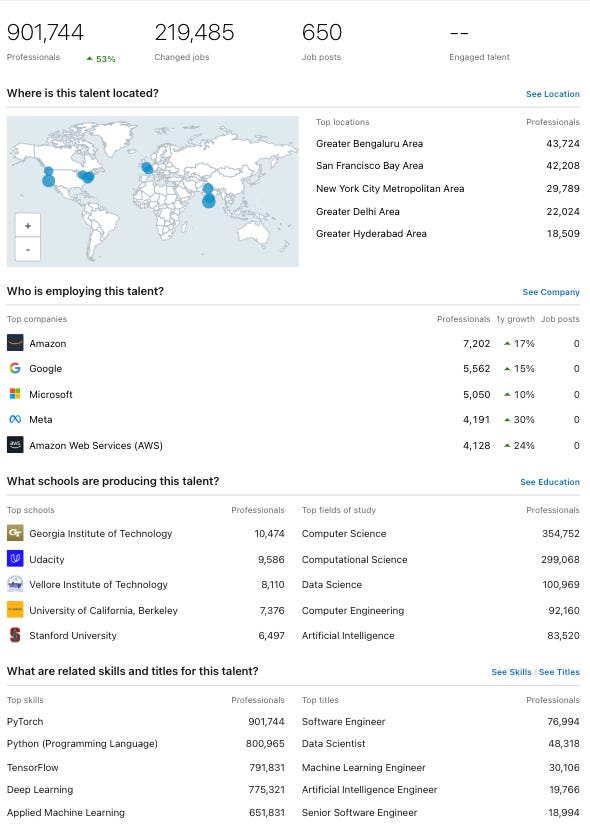1. What is PyTorch?
PyTorch is an open-source deep learning framework developed by Meta AI. It is designed to accelerate the process of building, training, and deploying neural networks, especially for AI and machine learning applications. With its dynamic computation graph and native Python integration, PyTorch allows developers to write intuitive, flexible code and seamlessly transition models from research to production. It supports GPU acceleration, making it ideal for large-scale model training, and has a strong ecosystem (e.g., torchvision, torchaudio, torchtext) for computer vision, audio processing, and natural language tasks.
In simpler terms, PyTorch gives software engineers and data scientists the tools to build AI systems—like recommendation engines, chatbots, or self-driving perception modules—using the same language they already know: Python.
Source: https://pytorch.org
2. Why is PyTorch in Demand?
The demand for PyTorch is being driven by the explosion of AI applications across every industry—from healthcare and finance to social media and autonomous vehicles. PyTorch is behind many of the most advanced AI models in use today, such as GPT, Llama, BERT, and Stable Diffusion. It is widely adopted in both academic research and production environments because of its usability, modularity, and performance.
Key reasons for its rising demand include:
- PyTorch dominates modern model development: 63% of machine learning models trained today use PyTorch.
- Companies are shifting from experimentation to deploying AI products in production, where PyTorch shines.
- AI job growth is booming, and PyTorch is explicitly listed as a required skill in many job listings.
Source: Shaping the Future of Generative AI Report by Linux Foundation

3. Employers Hiring for PyTorch Skills
PyTorch talent is in high demand across a broad spectrum of organisations, from big tech and AI startups to research institutions and enterprise leaders.
Top Employers Hiring for PyTorch Skills
FAANG & Tech Giants:
- Meta, Google (including DeepMind), Microsoft, Amazon, and Apple use PyTorch across their AI research divisions, product teams, and infrastructure services.
AI Startups:
- OpenAI, Hugging Face, Anthropic, Cohere, and Stability AI use PyTorch to build state-of-the-art models for language, vision, and generative tasks.
Enterprises:
- NVIDIA (for model optimisation and GPU acceleration), Tesla (for autonomous driving), IBM, and Adobe employ PyTorch in areas like image processing, robotics, and enterprise AI tools.
Research Labs & Academia:
- Stanford AI Lab, MIT CSAIL, and FAIR (Facebook AI Research) use PyTorch as their primary research framework.
These companies are leveraging PyTorch to create real-time, production-grade AI systems. From cloud providers to cutting-edge AI labs, PyTorch is now a core skill across the AI and software landscape.
Source: LinkedIn Talent Insights, 2025 dataset

4. Industry Trends and LinkedIn Insights
Based on the latest LinkedIn Talent Insights data:
- 901,744 professionals list PyTorch as a skill, showing a 53% increase YoY
- 219,485 people changed jobs in the past year
- Top job titles include Software Engineer, Data Scientist, Machine Learning Engineer, and AI Researcher
- Top locations include:
- Greater Bengaluru Area (43,724)
- San Francisco Bay Area (42,208)
- New York City Metropolitan Area (29,789)
- Greater Delhi and Hyderabad Areas
- Top related skills: Python, TensorFlow
- Top institutions producing this talent: Georgia Tech, UC Berkeley, Stanford, VIT, and Udacity
These stats highlight how global, fast-moving, and competitive the PyTorch talent market has become.
Source: LinkedIn Talent Insights, 2025 dataset

5. Widely Used Products and Applications Built with PyTorch
PyTorch powers real-world AI systems across domains:
- Large Language Models (LLMs) and Generative AI
- Models like GPT, Llama, and BERT are implemented in PyTorch.
- Powers tools such as AI writing assistants, code generators, and search engines.
- Computer Vision Applications
- Used in medical imaging (disease detection), retail (visual search), and security (facial recognition).
- Generative Models
- Enables GANs (Generative Adversarial Networks) and diffusion models like Stable Diffusion for creative image and video generation.
- Recommendation Systems
- Used by streaming services, e-commerce, and social media platforms for personalization.
- Autonomous Vehicles
- Powers object detection, lane tracking, and perception modules in self-driving cars.
- Speech and Audio Processing
- Used in voice assistants, transcription tools, and music generation systems.
- Robotics
- Enables control systems and reinforcement learning in advanced automation.
- Healthcare and Life Sciences
- Cancer detection, predictive analytics, and drug discovery models.
- Financial Services
- Applied in credit scoring, fraud detection, and algorithmic trading.
- Edge and Mobile AI
- Tools like TorchScript and PyTorch Mobile support AI inference on smartphones and IoT devices.
Companies like Meta, Apple, NVIDIA, PepsiCo, and Walmart are known to deploy PyTorch-based solutions in production.
Sources:
- https://pytorch.org/community-stories
- Engineering blogs: Meta AI, Google AI, Microsoft Research
Final Thought: Why the PyTorch Surge Matters and How to Get Started
For tech professionals—whether you’re in software engineering, data science, product, or devops—PyTorch is a future-proof skill. As AI becomes embedded in every product and service, understanding how to build, train, or even just evaluate models will become essential.
Learning PyTorch can:
- Open doors to high-paying, in-demand roles in AI and ML
- Help you build cutting-edge tools for work or side projects
- Future-proof your technical career with versatile, applicable knowledge
How to Get Started:
- Official Tutorials: PyTorch Tutorials and PyTorch Beginner Series (Youtube)
- Courses:
- Playgrounds: Google Colab and Kaggle offer free GPUs to run PyTorch models
- Prompt Engineering: Use tools like ChatGPT to generate and explain PyTorch code interactively
- Join the Community: Forums, GitHub, Reddit’s r/PyTorch
You don’t need to be a PhD to get started. If you know Python and have an interest in AI, you can begin building your first PyTorch model this weekend.
